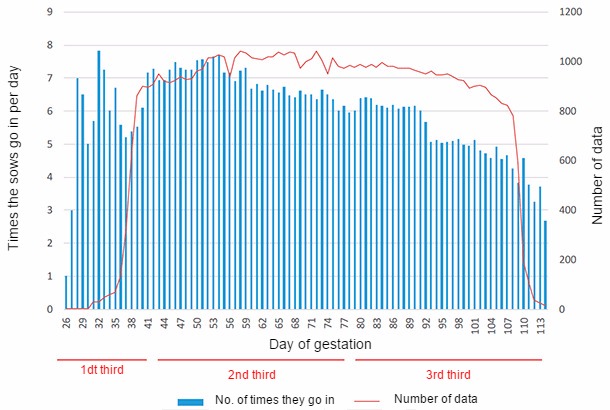As we mentioned in our previous article, we are now presenting the first results obtained by cross-matching data from different sources. In this case, production / reproduction data with data from feeding machines.
The first example (Figure 1) shows the number of times the sows enter the feeding machines per day. These data, collected in the Swine Experimental and Training Centre in Aguilafuente, are still unpublished because these are preliminary studies that, nonetheless, show the great value of cross-matching information. According to the graph, more than half of the sows (57%) enter the feeding machine between 2 and 5 times a day. It is true that there is great variability, with some sows going in once and some others more than 20 times; however, this simple graph gives us an idea of the food intake frequency amongst the sows of this farm: between 2 and 5 times a day.


Figure 1. Number of times the breeding sows enter the feeding machines per day
(PigCHAMP Pro Europa, 2015, unpublished data.)
When we look beneath the surface and analyse the average number of entries in the feeder based on the sows gestation stage, we see that it varies significantly depending on how far advanced gestation is (Figure 2). In the last third of gestation the sows enter the feeder an average of 5.2 +/- SD = 0.95 times the feeder, compared to 6.1 +/- SD = 0.92 (p-value = 0.005) and 6.9 +/- SD = 0.45 (p-value < 0.0001) in the first and second third of gestation, respectively.

Figure 2. Daily entering frequency depending on the day of gestation (PigCHAMP Pro Europa SL 2015, unpublished data).
But the key point, obtained by cross-matching the data provided by the machines, is that there appears to be a relationship between the number of entries and the total births, the sows visiting the feeder 10 or more times producing an average of 1.1 piglets less.
This finding, the first of many we hope to find with this approach (which needs further research as these are only preliminary data), reflects the great value of the hidden information for the efficiency of our business. The good news is that we still have a lot of room for improvement in many aspects.
It is important to keep this line of work, which includes the collection of information and its subsequent individual and cross-analysis, allowing us to make the appropriate decisions. This has only just begun. The analysis of large masses of data will reveal more hidden patterns that can be used to benefit the sector in many areas.



